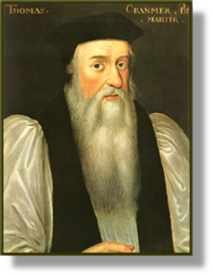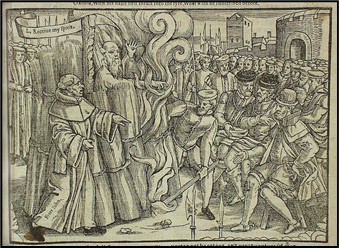


xxxxxAs we have seen, Cranmer was appointed Archbishop of Canterbury in 1532. He annulled Henry VIII's marriage to Catherine of Aragon in 1533 (H8), and set about the establishment of an independent English Church. Then, during the reign of Edward VI he played a major part in the compilation of two prayer books and, when the young king died, he supported the protestant Lady Jane Grey. It is not surprising that, on coming to the throne, Mary I had him imprisoned in the tower and then burnt at the stake in 1556. His death, together with those of Ridley and Latimer, lost Mary much of her dwindling support.
THOMAS CRANMER 1489 -
Acknowledgements
Cranmer: 16th century, artist unknown – Lambeth Palace, London. Execution: 16th century woodcut, artist unknown, contained in Foxe’s Book of Martyrs, published 1563.
 xxxxxAs we have seen (1533 H8), Cranmer was appointed archbishop of Canterbury in 1532 and, together with Thomas Cromwell, became one of the prime movers in the establishment of the independent Church of England. Within five days of his becoming archbishop, he declared Henry VIII's marriage to Catherine of Aragon void from the outset, and his marriage to Anne Boleyn entirely lawful. Under his direction, papal authority was no longer recognised, many Roman Catholic festivals were abolished, and Thomas Becket's shrine in Canterbury Cathedral was desecrated. Indeed, so fervent a Protestant did he become, that when Henry VIII re-
xxxxxAs we have seen (1533 H8), Cranmer was appointed archbishop of Canterbury in 1532 and, together with Thomas Cromwell, became one of the prime movers in the establishment of the independent Church of England. Within five days of his becoming archbishop, he declared Henry VIII's marriage to Catherine of Aragon void from the outset, and his marriage to Anne Boleyn entirely lawful. Under his direction, papal authority was no longer recognised, many Roman Catholic festivals were abolished, and Thomas Becket's shrine in Canterbury Cathedral was desecrated. Indeed, so fervent a Protestant did he become, that when Henry VIII re-

xxxxxTo put it mildly, this was hardly a curriculum vitae to endear him to the Roman Catholic Mary Tudor! Upon her succession he was confined to his palace at Lambeth, and then imprisoned in the Tower of London, accused of heresy. In March 1554 he was taken to a common prison in Oxford and there, under constant interrogation, he made seven recantations of his Protestant beliefs. However, when his life was not spared, he repudiated all his recantations and, whilst being burnt at the stake in 1556, put into the flames the hand that had signed them.
xxxxxCranmer's death, together with those of other Protestant martyrs -

 xxxxxIncidentally, the English dramatist John Heywood (c1497-
xxxxxIncidentally, the English dramatist John Heywood (c1497-
Including:
John Heywood

M1-


